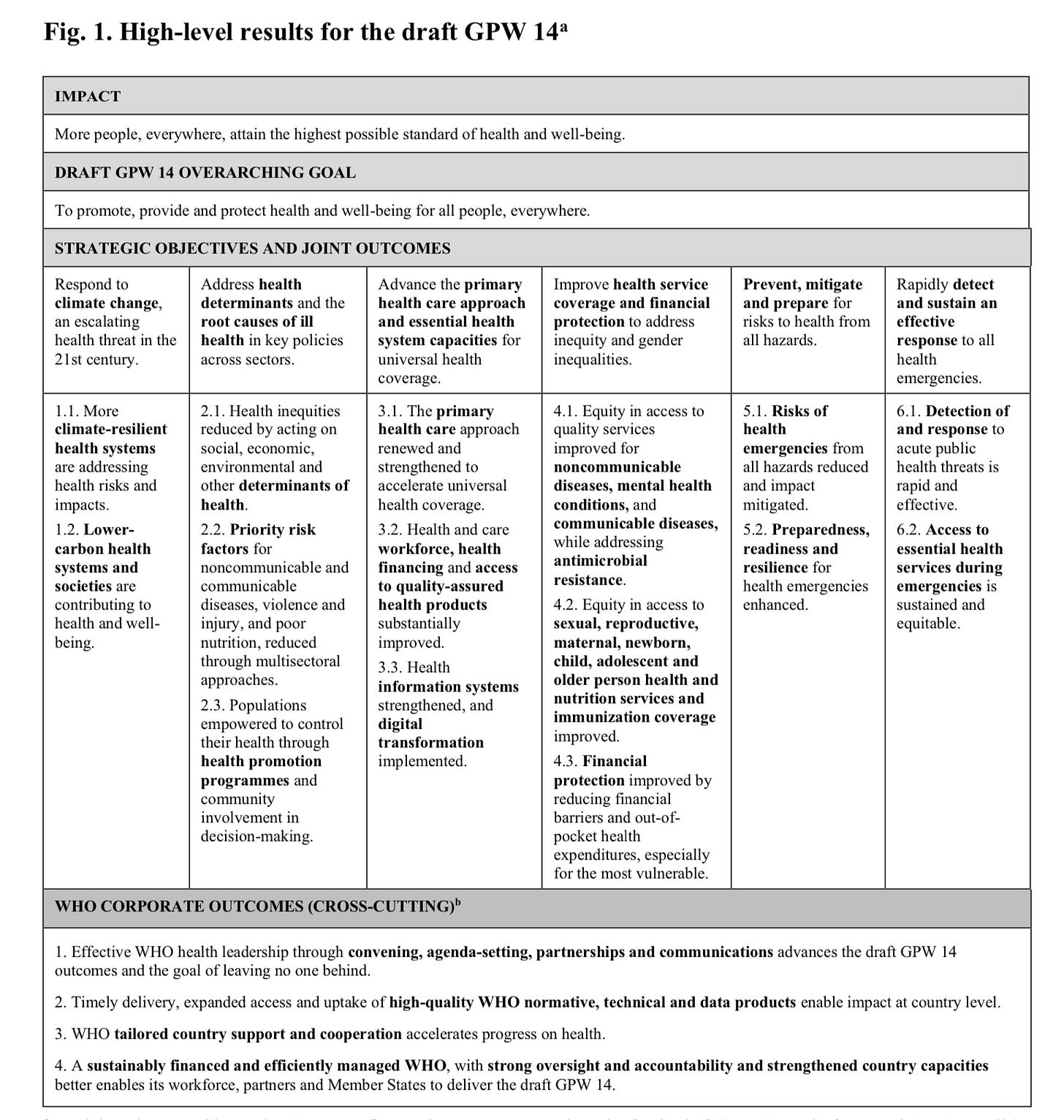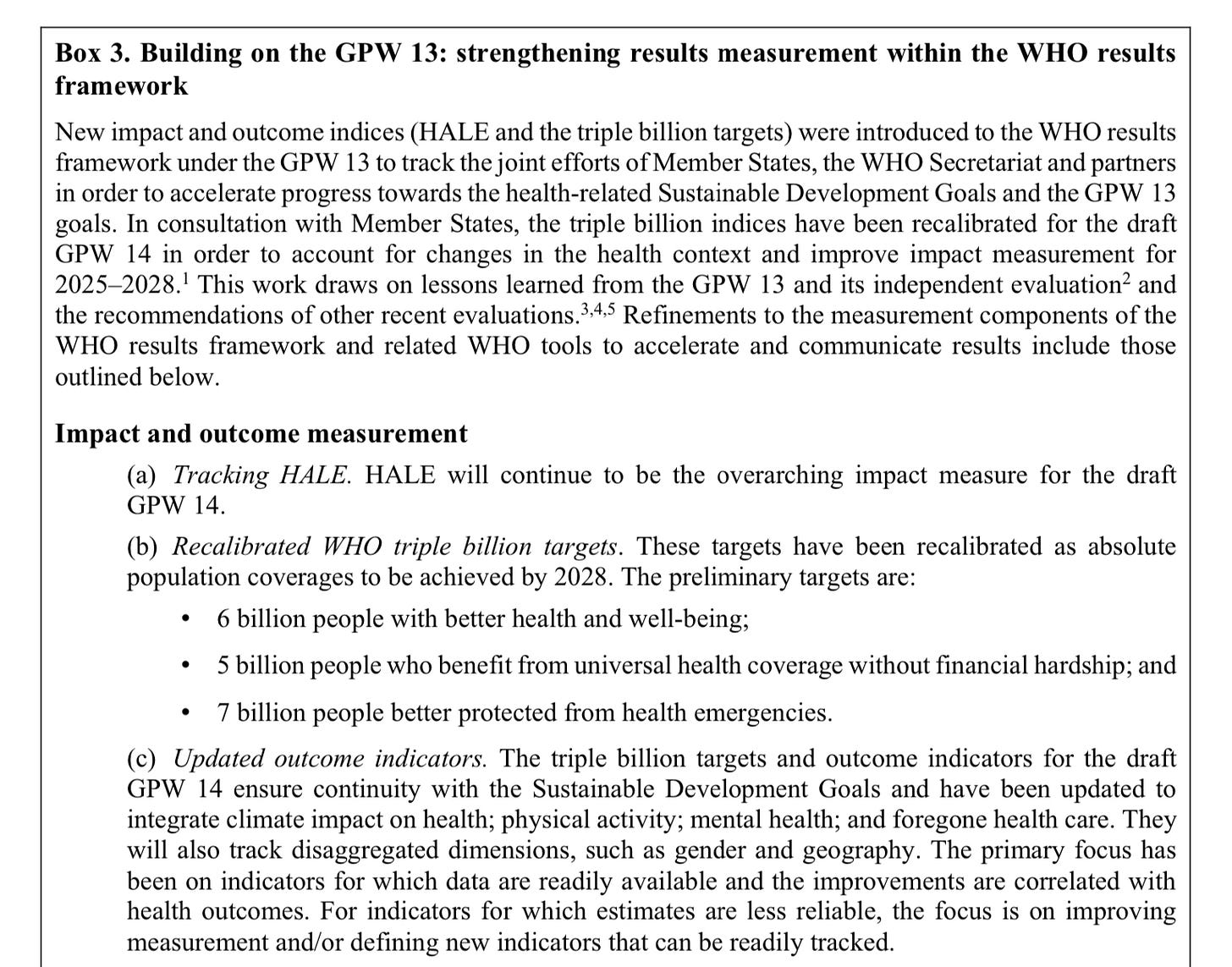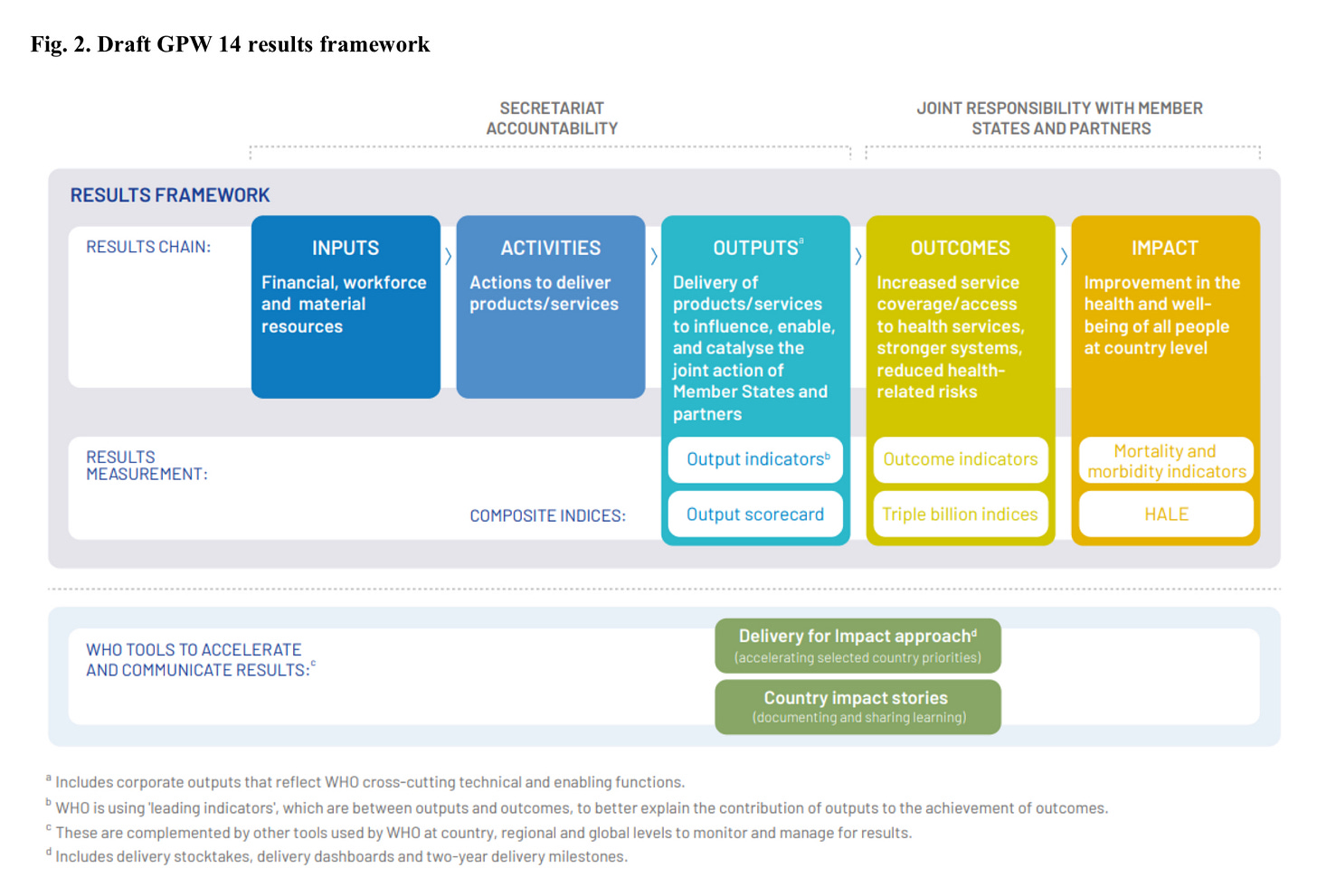At the upcoming World Health Assembly, Member States will consider and likely approve WHO’s new strategy, known as its 14th General Programme of Work (GPW14). Since WHO is so central to global health, its strategy does influence the field and what individual countries are doing in health, which makes it of wider importance. So although this blog is focused on GPW 14, it will be of interest to anyone in global health.
Because a strategy is only as good as its implementation, my goal is to help shape the implementation of the strategy by identifying now its strengths and weaknesses. I am a strong supporter of WHO, its central role in global health, its full and flexible funding, and optimizing its measurable impact in countries.
This blog provides Member States an analysis of GPW 14 from a results-focused lens. Also, many Member States may not have the capacity to fully analyze every document presented to them by the Secretariat: for them, this blog can provide a helpful summary of GPW 14 from a results perspective.
Last January, I outlined four principles for a results-based strategy. This blog will analyze to what extent these principles have been met by the draft GPW14.
In 2017 my brother Dr Tedros came to WHO with the vision of promoting measurable impact in countries. This blog outlines specific steps to further advance this vision in the context of implementing GPW 14.
Define the problem in quantitative, SDG terms
GPW 14 meets this principle. Defining the problem is important because it provides the ‘burning platform’ for the solutions. GPW 14 has perhaps an overly comprehensive description of SDG progress. However, it also has an easily digestible overview of how the world is doing on the triple billion targets of the earlier strategy, which were meant to consolidate SDGs for ease of understanding.
Set objectives for what your organization does and how it will speed up SDGs
GPW 14 mostly meets this principle. It outlines five ‘Ps’ as a framing mechanism: promote, provide, protect, power and perform. The first three are about ‘what’ WHO does and the latter two about ‘how’ WHO does it. These are shown in the chart below. It is clear from the text (although not in the chart below) that ‘Promote’, ‘Provide’, and ‘Protect’ are the ‘strategic objectives and joint outcomes’ (each split into two), while ‘Power’ and ‘Perform’ are the ‘corporate outcomes’ (the first three and last one, respectively).
Later in the text we get more details on the ‘how.’ Across the 4 ‘corporate outcomes’ there is a list of 17 ‘areas of work.’ This is a certainly a comprehensive list of ‘how’ WHO operates. What is missing is the focus on which levers will most speed up SDG progress, and how to measure them.
I have somewhat undiplomatically called this more focused and leveraged approach GSD (Get Sh*t Done) on the SDGs. I have identified three key levers for speeding up the SDGs: results-based governance, delivery for impact, and scaling innovation. I have also identified tools for measuring these, as well as illustrated how the approach applies to a concrete issue, Universal Health Coverage (UHC). I would argue that these three key output targets below in future implementation of GPW 14 would significantly accelerate SDG progress:
Executive Board and Regional Committee meetings take a results-based governance approach using recalibrated billions targets and delivery dashboards (see below).
Delivery for impact approach used in 100 countries.
10 innovations (including products, service delivery, digital and financial innovations) scaled to 100 million people each.
These levers are all found across the 17 ‘areas of work’ under 4 ‘corporate outcomes’ in GPW 14 but diluted out in the wider list and to some degree blunted (e.g. GPW 14 talks about “strengthening results-based management through a strong programme budget” but not results-based governance; “helping countries accelerate progress towards national health and the draft GPW 14 targets” but not a specific target on delivery for impact in countries; and “scaling up the science and innovation capacities of WHO and countries” but not scaling specific innovations reaching 100 million people each).
Propose a few bold SDG-based outcome targets and measure progress against them
This principle is mostly met but the bold targets are diluted out by many others. Here are the bold “triple billion” targets:
So 6-5-7 billion is the new ‘triple (i.e., 1-1-1) billion.’ This is good. It provides the basis for results-based governance. These are the same outcome indices as in WHO’s earlier strategy but recalibrated for the 2025-2028 period and expressed in absolute rather than relative terms. The figure below (left panel) illustrates this for the UHC billion, showing that 5 billion is a reasonable absolute target for the UHC billion under various best practice/SDG goals met scenarios. More details can be found in my recent blog on UHC.
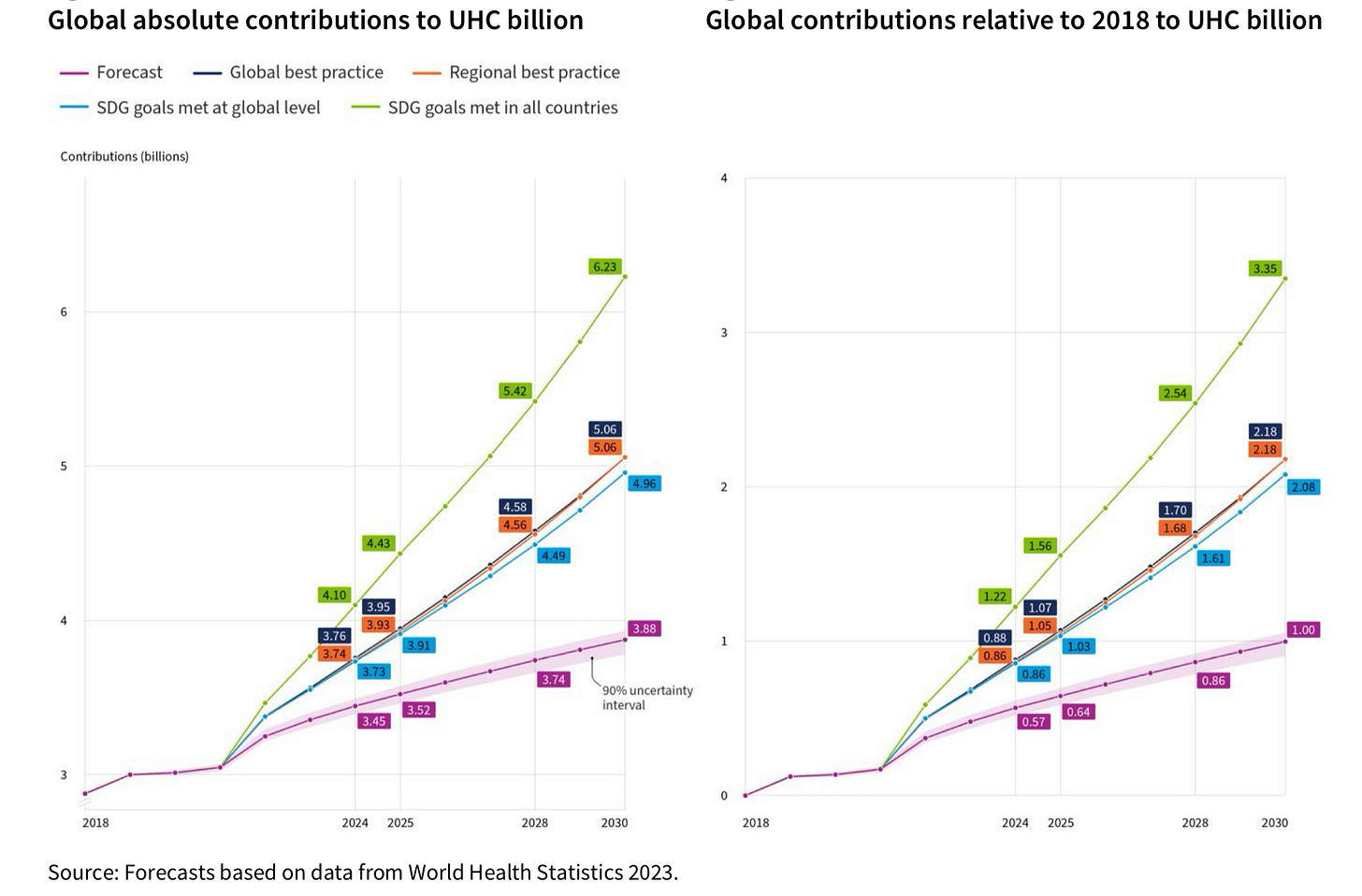
It also makes sense to have programmatic indicators and targets to go into more detail underneath these billions. The annex of GPW 14 lays out 100 ‘draft joint outcome indicators’ for ‘Provide’, ‘Promote’ and ‘Protect.’ More than 50 of these are new (compared to GPW 13) and many will not have data or targets. As the saying goes, if you have 100 indicators, you have zero indicators.
So the opportunity in implementing GPW 14 is to keep a sharp focus on progress against the 6-5-7 billion targets (for Promote, Provide, and Protect respectively) and to quickly determine which of the very many indicators have data and targets to support them.
Measure and manage outputs to drive SDG outcomes and be accountable
This principle is mostly met but there are separate systems to measure and manage outputs, leading to a potential disconnect between accountability (‘results chain/measurement’) and driving SDG progress (‘WHO tools to accelerate and communicate results’). This is illustrated in the chart below from GPW 14:
The problem here is a bit technical, but the details matter. First, for each outcome indicator there is normally at least one, often more, output indicators. So if GPW 14 is swimming in outcome indicators, it will be swimming even more in output indicators. This risk can be reduced by grouping ‘joint outcome indicators’ as GPW 14 does, but then the measurability of these outcomes, as discussed above, becomes even more important to establish. Second, the output scorecard — which contains elements of health leadership; global public health goods; technical assistance and operational support; gender, equity and the right to health; and value for money — is disconnected from explicit drivers of SDG progress. In other words, these elements are not easily actionable.
Finally, actionable elements of SDG progress in the delivery for impact approach are not formally part of results measurement so they do not necessarily serve as the basis of budgetary decision making, which is what really drives the organization. These elements are shown below for comparison with those in the output scorecard:
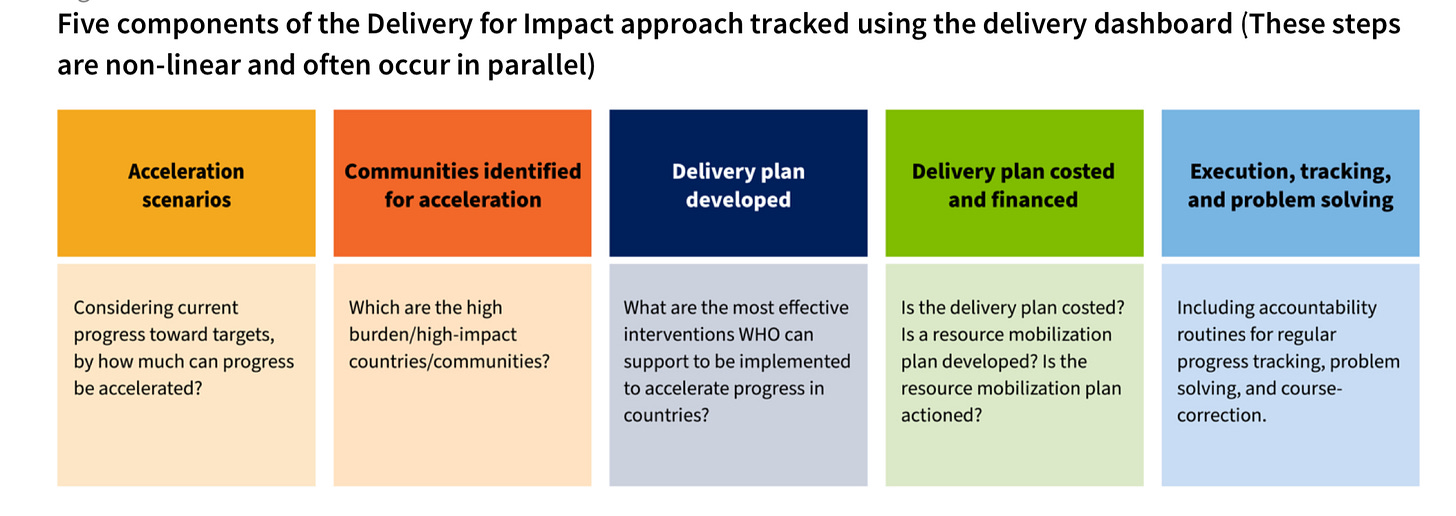
This dashboard below shows how these elements can be used to both measure and manage outputs using the same system, reduce data collection burden, and make the results more actionable:
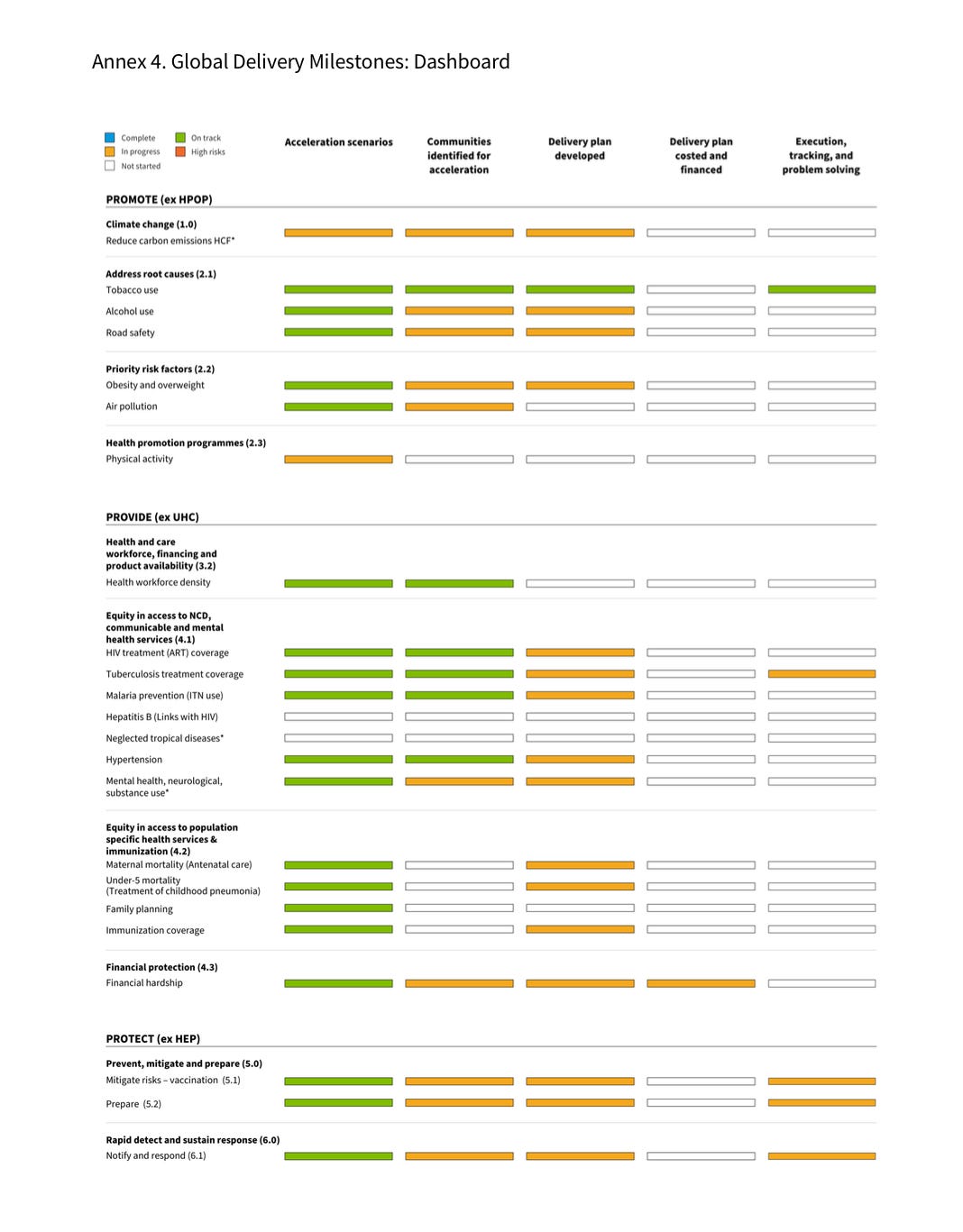
Delivery for impact is useful not only for managing results, but also for measuring them, which can lead to more effective and efficient resource allocation and greater governance accountability. The opportunity is to integrate it more closely into programme budgets and governing bodies meetings.
Delivery is the best diplomacy
By focusing on key principles of results-based strategy, we can easily see the strengths and weaknesses of GPW 14 and how it can be improved in implementation. Key implementation elements include the investment case (for raising funds), the programme budget (for allocating funds) and the results report (for accountability).
Overall, WHO is much more results focused than it was in 2017 when Dr Tedros’ term began. With some key improvements, WHO could be even more results focussed, more accountable, and ultimately better support countries to accelerate SDG progress. At the moment, the geopolitics are challenging and progress on the SDGs is lagging. These key improvements could also help in part to future-proof WHO. I am not so naive to believe delivery of results can solve the challenges of geopolitics and diplomacy. But it can help.
For WHO, delivery is the best diplomacy!
Ultimately, it is the governance of any organization that is responsible for demanding results and accountability — from themselves (because countries are responsible for the SDGs) and from WHO (which is there to help countries to achieve the SDGs). The opportunity is better value for money invested at a time when resources are increasingly scarce, a more effective and efficient WHO and multilateral system, and ultimately better health for all. Of course, the ultimate measure of strategy is not its development but implementation and results in countries.






